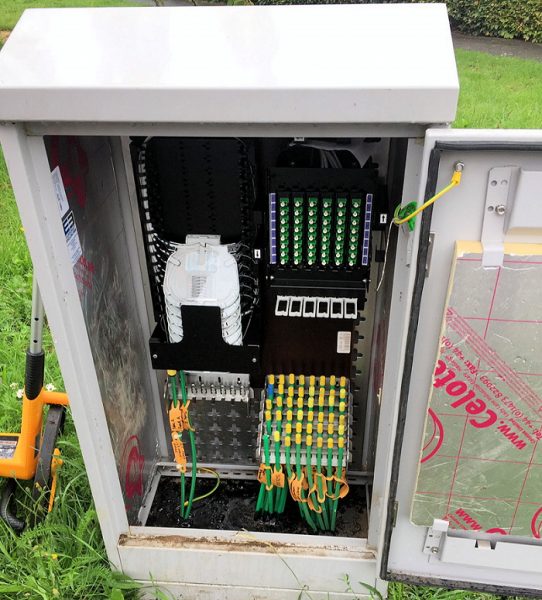2,000 Premises in Peacehaven Get Virgin Media FTTP Broadband

Broadband ISP Virgin Media UK has officially completed the expansion of their gigabit-capable Fibre-to-the-Premises (FTTP) network in the East Sussex town of Peacehaven, which means that 2,000 further homes can now access their internet, phone and TV services.
As usual this work formed part of the operator’s £3bn Project Lightning build, which originally aimed to add an additional 4 million premises to their UK coverage (so far they’ve completed c.2.2 million) using a mix of FTTP via Radio Frequency Over Glass (RFoG) and Hybrid Fibre Coax (HFC) technology. Both methods make use of the DOCSIS standard so as to share the same consumer hardware.
At present the best (average) broadband speed that local residents can access via Virgin Media goes up to 516Mbps, but this should reach 1Gbps+ by the end of 2021 (i.e. once their DOCSIS 3.1 upgrade has completed).
Advertisement
Mark is a professional technology writer, IT consultant and computer engineer from Dorset (England), he also founded ISPreview in 1999 and enjoys analysing the latest telecoms and broadband developments. Find me on X (Twitter), Mastodon, Facebook, BlueSky, Threads.net and Linkedin.
« Vodafone UK Extends Free Unlimited Data for NHS to PAYG























































Is there anyway to find out how far east of Peacehaven they will be going?
Almost within touching distance of Peacehaven so if they continue east I might get something better than the 25 max I can get now due to distance from the cabinet.
Failing that an alnet could swoop in and have free rein of 40,000 houses of nearby towns in the area and large town.
I feel like FTTP is too wildly confused now.
Don’t get me wrong, it does still mean what it is but Openreach FTTP vs Virgin FTTP vs Vodafone FTTP has differences!
Eg. Virgin FTTP is just HFC with the last metres using Fibre instead of Coaxial (Currently) but then converted to coaxial priory to modem thus still using a DOCSIS RF technology
Eg. BT Openreach fibre all the way to the modem (ONT) and Vodafone only used as they provide symetric service.
Opinions?
They are all FTTP.
Virgins FTTP is NOT HFC.
It is still DOCSIS but it is very much FTTP.
HFC parts of Virgins network have coax from the cabinets to the home.
You don’t say OpenReach FTTP isn’t FTTP because there’s a copper Ethernet cable between the ONT and the router.
Although Vodafone offer symmetrical speeds to the customer they don’t deploy a symmetrical network.
They have the exact same architecture as OpenReach but they offer higher upstream.
Vodafone’s FTTP would see much more congestion if lots of neighbours all took the 900/900 package.
Openreach deploy GPON with a 32 way split.
CityFibre (Vodafone GigaFast) is also GPON with a 32 way split.
B4RN do point to point fibre rather than a shared PON.
I wonder what the conversion overhead is for Virgin Media fibre to be converted from FTP to DOCSIS 3.0. I have Vm’s FTTP in my area but I haven’t switched yet because I don’t like the idea of converting Fibre to DOCSIS and the extra electricity that equipment uses. You don’t see major datacenters using DOCSIS for a simple reason it’s not as efficient . Also surely latency would be affected to?
@Jason
You don’t see docsis in datacentres because it’s a consumer / soho broadband technology. You don’t see FTTP in datacentres either, for the same reason, just leased lines with direct Internet access (DIA).
@John
I’m with VM as Openreach in my area is unreliable (intermittent connection and distance from cab giving me less than full speed) and I really didn’t want to be with them given my experience in the past having lived in an oversubbed area. Now I’m living in a Virgin FTTP area and I’m constantly the full speed pay for (more than advertised) and the latency is only slightly higher than Openreach. No other provider in my area can give me the speed or reliability I need. Openreach tops out at 50 and is more expensive. With VM I’m getting nearly 400/40.
@John – Please read my original comment again, FTTP in my opinion is where a fibre terminates in CPE, Virgins fibre still terminates on their side of the network.
@Archie – Glad to hear you have good service, I know your predicament with Openreach FTTC as I experienced issues before in previous addresses, however please note the experience of one doesn’t match the many and also requirements differ, you want bandwidth others want stable latency or other pros and cons for each of the different services.
@Matt
Note that I’ve already mentioned about experiences differing, so… note, note, note and perhaps read before you say ‘note’. Just giving you notice.
That’s is Matt Openreach FTTP vs Vodafone FTTP those 2 are pure Fibre. But Virgin Media is half FTTP and from the cabinet it’s HFC so Virgin isn’t full fibre. You should know this Jo
That’s not true. The FTTP areas are fibre right to the home.
The HFC areas are indeed fibre to a node, not cabinet, node as there are likely cabinets in between, however the FTTP areas deliver fibre right to the home.
You should know this.
@CarlT – Wouldn’t it be more of a FTTB type of thing, the fibre doesn’t terminate in CPE so I wouldn’t consider it FTTP…. however this is why I posted my original comment.
The difference is very subtle in Virgin’s setup. In most FTTP deployments the fibre will go to an ONT on the inside wall and then copper Ethernet cable to your router. In Virgin’s FTTP the fibre goes to a powered RFoG node on your outside wall, which then sends the signal via a very short coax to the internal wall box (power source) and on to the router etc.
You could get into a tedious argument over FTTB vs FTTP about this one but most people do just consider that as Virgin’s fibre reaches directly to an individual property (usually on the outside wall but it can be inside if there’s an access issue), then that’s close enough to be considered FTTP.
In a normal FTTB setup it’s copper that goes to each individual apartment and over a much longer run of many metres from the basement.
Hi Mark – I’m not here to argue, I brought the topic up as a discussion because as you just clarified there s technical differences which might not be an issue right now but sure will be down the road.
What you did just remind me was the term of RFoG which is pretty much how I will consider Virgin’s FTTP going foward.
Yes HFC IS COPPER that’s why it’s called hybrid fibre coax cable. Coax cable has a copper core. Fibre from cabinet or node then HFC from the cabinet or Node to your house.
Your posts are all wrong. The coaxial cables between the optical nodes and the customer premises have a copper-coated core of aluminium or steel which conduct signals, with the copper used to shield the signals from interference.
If you’d kindly read my post you’ll note I detailed in far more depth than you, someone with no idea what they’re talking about, what HFC actually is.
I also noted that Virgin Media have FTTP which is indeed full FTTP.
Roger_Gooner that post is very wrong. No-one, ever, uses copper directly touching something else to insulate – copper is a conductor and in contact directly with something else, coating it, it’s going to increase the noise received by the core.
The copper coating is because of the skin effect – https://en.wikipedia.org/wiki/Skin_effect – copper on the outside takes advantage of this and provides lower attenuation where the signal is actually travelling without the expense of having the entire core copper.
CarlT, of course the copper is layered over the insulator and not literally covering the core. But the whole point of my post was that the copper is for shielding and not for signal transmission. Of course the cable inside properties is different in having a copper core.
The copper coating on the steel in coax is entirely for signal transmission.
It also very literally covers the core – the core is copper plated steel for the most part.
Someone is confused over the shield, inner insulation and then the inner conductor that is carrying the signal which is as pointed out steel with a copper coating.
God every one seems to be auguring over FTTP, FTTC ETC virgin Media have a mix now to cabinet which is usurpation in ur street and FTTH but with doc 3.1 coming who cares what ur on if ur on old new or horse and cart we are all going to get a big boost I get 519mb tv apart sports unlimited landline and I’m on the old docsi 80s line… ♂️ N now 02 r coming in big changes I see I don’t see liberty network I don’t see 02 more virgin I see a new beginning tv, broadbands, mobile they have all said they invest so let’s see I been a customer since teleost n now have the V6 which when horizon comes this somewe big things r coming….
Sorry not spelling spell check and slipping fingers etc
https://www.virginmedia.com/corporate/media-centre/press-releases/virgin-media-announces-largest-uk-fibre-broadband-rollout
Well to honest with you all am just so glad the Industry Is moving from old slow internet to Full Fibre. I am not so Keen on Openreach’s Fibre to the Cabinet VDSL2 Technology. I think we can all agree on the one
The main question to answer is “What extra does Virgin FTTP give you over their same service using POC (plain old co-ax)? From what I can see, there is no extra benefit, and DOCSIS (a hack introduced to get broadband up and down over a TV broadcast system) is still there and the service is identical whether over FTTP or co-ax. Not necessarily a bad thing as co-ax is much better on data than telephone wire and the speeds are up there on co-ax, however it is still a complex RF soup of tricks to get those speeds over co-ax, which is unnecessary over fibre, but still in play on Virgin FTTP.
Virgin’s FTTP is the equivalent of Openreach deploying their FTTP with DSL over fibre. So you get a VDSL or G.Fast signal converted to go over fibre, then it gets converted back to a two wire electrical DSL signal, connects up to the same master-socket and is then connected into the same VDSL or G.Fast modem. Yes you would be able to deliver a very fast signal using G.Fast over a couple of metres, but it is an extra complication that isn’t required.
Virgin is using FTTP as pseudo co-ax, so despite being fibre it is running in co-ax compatibility mode. Others like Openreach are actually building a brand new FTTP network using fibre running protocols designed to get the best out of it.
Nothing to stop Virgin upgrading the last few metres of their pseudo co-ax fibre network and ditching DOCSIS in the future, but surely the best time to do that is now, rather than a big upgrade required later.
Indeed although I’m not sure if their STB can accept ethernet to provide TV services? Might require a new box.
PFTTP – Pretend fibre to the premises?
What it brings is that with a simple change of a module in the ONT you can have an EPON passthrough allowing VM to offer customers a share of 10 Gb/s symmetrical.
The kit is running in ‘backwards compatibility’ mode to stay consistent with the rest of the VM network much as every other cable operator is. Why? Simple – the cost of CPE and the provisioning equipment around it. They have millions of cable boxes and Hubs in stock, the systems are built around managing these.
RFoG can run side by side with EPON and XGSPON. It’s fine.
The extra you get is from getting rid of the whole HF chain.
Because the backhaul is pure fibre all the way the bandwidth you get is precise with no vaguaries of analogue HF electronics. Being full FTTP it will also be much more reliable.
For consumer use the solution VM have come up with is pragmatically driven by the need to keep the fleet of boxes consistent.
When the VM FTTP footprint becomes larger I can see VM forking to provide a pure FTTP product in the areas that can. They will need to as they will have to market against all the other entrants an OR.
The is no reason for the VM FTTP part of the network not being able to go closer to symmetric using XGSGPON etc
If I had a choice between FTTC and VM FTTP then I’m pretty clear I’d go down the VM route. My previous experience with the HFC offering was less than brilliant and I have to say GFast is a better product in terms of ping and stability but not in terms of universality.
You have just been saying what have been trying to say buddy. Yes Virgin Media May say there using FTTP but actually they do use fibre optic broadband. But what I am trying say Virgin Media thinks your there customers are stupid they use HFC witch is Hybrid Fibre Coax Cable. Think of it like Openreach’s FTTC VDSL2 Openreach uses Fibre to the Cabinet and then telephone cable to the house. But HFC on the other hand is Virgin Media’s Version of FTTC Fibre Optic Broadband they Fibre Optic Broadband to the Cabinet or Node and Copper Coax cable for last mile. That’s the same cable it gets for TV Aerials/Sky/Cable TV DAB Digital aerials.
@CarlT
“What it brings is that with a simple change of a module in the ONT you can have an EPON passthrough allowing VM to offer customers a share of 10 Gb/s symmetrical.”
Simple on paper, but rather complicated and expensive over potentially millions of customers. Also where are they going to house the kit and OLTs for providing such a service and would their FTTP network topology allow for an easy upgrade regarding splitters and numbers on a single fibre without considerable work. Questions we probably can’t get answers too, but going the compatibility route now for cost reasons often means poor decisions are made that whilst it works now, does not necessarily in the future. I suspect Virgin will stick with DOCSIS for ever more.
Still Openreach face a similar issue where they will need to upgrade ONTs for when they go for faster versions of GPON, but in their case they add the new OLTs in a nicely connected and cooled building without needing to visit hundreds of cabinets or reworking their network, so it just a simple swap out of an ONT for customers taking those faster speeds or on new deployments, i.e. Openreach FTTP is a nice newly build network for getting the most out of FTTP, the same as others offering FTTP. It is only Virgin deploying FTTP in compatibility mode.
Time will tell.
It won’t need extra ONTs or changes to the fibre network, just an ONT module swap when a customer changes service. 32 homes per OLT port, combining up to more normal cable node numbers happening within hubsites.
@CarlT, are we still talking about Virgin’s network? Do we know for sure if Virgin’s network topology on their legacy DOCSIS over Fibre is one OLT to 32 premises?
The semantics on this thread are hilarious.
Almost as funny as when the guy who runs an ISP got Virgin to install for him but only because he wanted to complain about the technology they used.
I remember her raised the complaint, they phoned hm back asking if it was an okay time to talk, he said yes and then he later complained that they’d phoned him. 😀
Some folk need to get better things to worry about.
https://en.m.wikipedia.org/wiki/Coaxial_cable
Coaxial cable, or coax (pronounced /ˈkoʊ.æks/) is a type of electrical cable consisting of an inner conductor surrounded by a concentric conducting shield, with the two separated by a dielectric (insulating material); many coaxial cables also have a protective outer sheath or jacket. The term “coaxial” refers to the inner conductor and the outer shield sharing a geometric axis.
Coaxial cable is a type of transmission line, used to carry high frequency electrical signals with low losses. It is used in such applications as telephone trunklines, broadband internet networking cables, high speed computer data busses, cable television signals, and connecting radio transmitters and receivers to their antennas. It differs from other shielded cables because the dimensions of the cable and connectors are controlled to give a precise, constant conductor spacing, which is needed for it to function efficiently as a transmission line.
Coaxial cable was used in the first (1858) and following transatlantic cable installations, but its theory wasn’t described until 1880 by English physicist, engineer, and mathematician Oliver Heaviside, who patented the design in that year (British patent No. 1,407).[1]
I resent this title because VM hasn’t covered all of Peacehaven. I live in North Peacehaven and VM has stopped cabling to the bottom of my street – much to my frustration. What is VM’s plan to cover all of Peacehaven and not just parts of it?